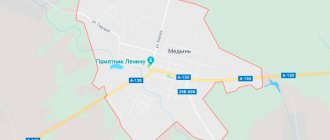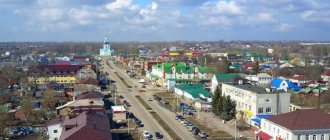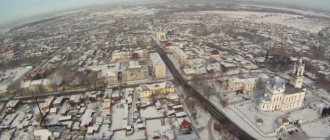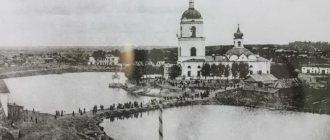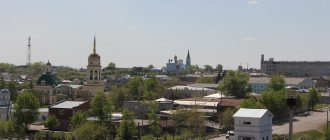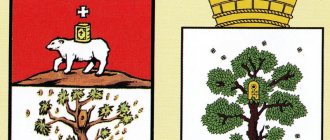| Rybinsk |
Rybinsk
, a city in Russia, the administrative center of the Rybinsk district of the Yaroslavl region, a cathedral city and the center of the Rybinsk city deanery of the Rybinsk diocese. Located on the Volga River, at the entrance to the Rybinsk Reservoir, 82 km northwest of Yaroslavl and 270 km north of Moscow. Within the city there is a dam at the Rybinsk Hydroelectric Power Station, which forms the Rybinsk Reservoir and the rivers Sheksna and Cheremukha (tributaries of the Volga River), as well as a number of small rivers and streams, flow through. River port and railway station. Population - 188.7 thousand people. (2018).
- On the map: Yandex.Map, Google map
A Stone Age site was found in the historical center of the city. The first written mention of a settlement within the boundaries of the modern city called Ust-Sheksna
dates back to 1071.
Archaeological finds indicate that Ust-Sheksna was a large trade, craft and metallurgical center. Since 1137, a settlement has also been known under the name Rybansk
. Ust-Sheksna was devastated during the Tatar-Mongol invasion.
In 1504, on the right bank of the Volga River at the confluence of the Cheryomukha River, Rybnaya Sloboda
. Sloboda supplied Volga fish to the Grand Duke's and then to the Tsar's table.
In the 17th century, a trading post appeared here. With the opening of the Vyshnevolotsk water system in 1709, connecting the Upper Volga region with St. Petersburg, the settlement began to quickly develop as a trade center and a place for ship transshipment. By the middle of the 18th century, Rybnaya Sloboda became one of the largest river ports in Russia.
In 1777, by decree of Catherine II, the Rybinsk district of the Yaroslavl governorship was formed and Rybnaya Sloboda was transformed into the city of Rybnaya
Rybinsk
has been in use since 1778 . Since the 18th century, the city has been built up according to a single plan created by the Yaroslavl provincial architect I. Levenhagen in 1784: some streets are parallel to the banks of the Volga, others are strictly perpendicular, the blocks are square in plan. Since 1796, Rybinsk has been part of the Yaroslavl province.
The Mariinskaya (since 1808) and Tikhvinskaya (since 1811) water systems that appeared at the beginning of the 19th century further increased the importance of Rybinsk. In the 19th century, the city became the largest trade and transport center on the upper Volga, where up to 100 thousand barge haulers and loaders gathered. From the second half of the century, industry developed intensively, flour mills, shipbuilding enterprises appeared, and in 1858 the rope-spinning factory of the Zhuravlev merchants appeared. In 1871, the railway connected Rybinsk with St. Petersburg and the Baltic ports.
Soviet power in Rybinsk was established on March 2, 1918. On July 8 of the same year, the White Guard Rybinsk uprising took place in the city, suppressed within a few hours. From 1921 to 1923 the city was the center of the Rybinsk province, and from 1929 to 1930 - the center of the Rybinsk district. Since 1936 - part of the Yaroslavl region.
From the early 1930s the city grew rapidly, transforming from a commercial to an industrial one. The city boundaries included the mouth of the Sheksna River and other left-bank areas. The largest engine-building plant in the city was created at the base, producing mainly aircraft engines. In 1932, the Rybinsk Aviation Institute opened in the city.
In 1936, as part of the “Big Volga” project, construction of the Rybinsk hydroelectric power station and hydroelectric complex began with the goal of creating a deep-sea route from the Volga to the Baltic and to the Moscow River, as well as providing the growing industrial center with electricity. Construction was almost completed before the start of the Great Patriotic War; in 1941, filling of the Rybinsk Reservoir, the largest man-made reservoir in Central Russia, began. The unfinished hydroelectric power station began to produce current during the war: on November 18, 1941, the first hydraulic unit was launched, and on January 15, 1942, the second, so that in 1942, after the construction of the power line, the Rybinsk current came to Moscow.
On September 13, 1946 the city was renamed Shcherbakov
in honor of the politician A.S. Shcherbakov, but in October 1957 the historical name
Rybinsk
.
On March 15, 1984, the city was renamed again - Andropov
, in honor of the General Secretary of the CPSU Central Committee Yu. V. Andropov.
In March 1989, the name Rybinsk
and the city districts: Proletarsky and Central were abolished.
| Rybinsk. Colorized photo of the turn of the 19th-20th centuries. |
Statistics
- 1856 - 8.6 thousand people, 4 churches, 626 houses, 522 shops
- 1897 - 25.3 thousand people
- 1913 - 29.9 thousand people
- 1926 - 54.2 thousand people
- 1939 - 139.2 thousand people
- 1956 - 162 thousand people
- 1970 - 218.3 thousand people
- 1989 - 251.4 thousand people
- 2003 - 222.7 thousand people
- 2017 - 190.4 thousand people
I. The territory of Rybinsk, incl.
Ga9 954 Lands administered by: - Russian Federation and Yaroslavl region, other Ga2 082 - Rybinsk, of which: Ga7 872 • transferred to the ownership of legal entities. and physical persons of Ga2 719.5 • transferred for use and possession by legal entities. and physical personsGa1 102• leased to legal entities. and physical personsGa355Area of built-up landGa6,072Area of undeveloped land, incl.Ga3,882—free plots for future constructionGa743Coat of arms
The coat of arms of Rybinsk is presented in the form of a scarlet French shield. In a red field above an azure belt, symbolizing a river, a green bank is depicted. The golden pier is adjacent to it. Gold double bridges extend over the belt. Below the design are two facing silver sterlets. A black bear emerges from behind the firmament. In his left paw he holds a golden ax. The handle rests on the animal's shoulder.
The artistic composition was adopted by the decision of the municipal council of the urban district of Rybinsk dated June 22, 2006 No. 51.
II. Demographic situation
Population as of 01/01/2021average for 2021Persons. 182 383
183 509
Born/died in 2021 People 1,397/3,465 Natural population decline in 2021 People-2 068 Arrivals/departures in 2021 People 2 519/2 654 Migration loss for 2021 People-135 Change in population including migration in 2020 People-2 203Marriages/divorces for 2021Person 1,281/782Dynamics by year
The population of Rybinsk by density is 2946 people per sq. km. Over two decades (from 2000 to 2020), the city’s residents decreased by 53.7 thousand people. As of January 1, 2019, Rybinsk ranks 102nd among cities in the Russian Federation in terms of population. The dynamics by year over the past 20 years are shown in the graph and table.
| Number of inhabitants (thousand people) | Years |
| 239 600 | 2000 |
| 238 300 | 2001 |
| 222 650 | 2002 |
| 222 700 | 2003 |
| 219 600 | 2004 |
| 217 500 | 2005 |
| 214 905 | 2006 |
| 213 100 | 2007 |
| 211 080 | 2008 |
| 206 700 | 2009 |
| 203 855 | 2010 |
| 200 310 | 2011 |
| 198 133 | 2012 |
| 196 568 | 2013 |
| 194 845 | 2014 |
| 193 340 | 2015 |
| 191 844 | 2016 |
| 190 430 | 2017 |
| 188 677 | 2018 |
| 186 578 | 2019 |
| 184 634 | 2020 |
Trend in demographic situation for 2007/2008/2012:
- births per thousand people – 9.3/9.6/10.7;
- deaths per thousand people – 18.4/18.4/16.7;
- natural decline per thousand people – 9.3/8.8/6.2.
III. Labor resources and employment
Population of working age /% of the total population Persons/% 98,821/53.5 Number of employees (without external part-time workers), of which - in large and medium-sized enterprises and organizations Persons 51,813 - in small enterprises (including micro-enterprises) Persons. 9,500—individual entrepreneurs Persons 3,398 Number of employees in large and medium-sized enterprises and organizations by type of economic activity, of which: People 51,813 • in manufacturing—20,598 • in the provision of electricity, gas and steam; air conditioning—2,208• in water supply, sanitation, waste collection—837• in transportation and storage—2,693• in wholesale and retail trade—1,917• in education—5,921• in healthcare and the provision of social services—5,675• in culture, sports, organization of leisure and entertainment—1,006 Number of officially registered unemployed Persons 2,313 Share of unemployed in the working-age population% 2.4National composition
Almost 95% of the population of Rybinsk are Russian. The rest of the national composition is represented by the majority of nationalities of the former Soviet Union, near and far abroad. There is no strict stratification along ethnic lines in the city; the attitude of the local population towards visitors, tourists and guests is predominantly tolerant. Ethnic names: Rybinsk, Rybinka, Rybinets.
As for the culture of behavior, this is affected by the territorial location in the European part of Russia and proximity to the cultural centers of the country. Rybinsk residents have their own solid cultural reserve, which they can proudly show to visitors.
If you don’t walk through dangerous areas at night, where excursions and walks are clearly inappropriate, you will still have a pleasant impression of the city. The same can be said for most other places in the world, since everyone is different. And you certainly shouldn’t judge the whole of Rybinsk based on a single negative impression.
IV. Income of the population.
Average monthly nominal accrued wages (full range of enterprises and organizations) RUB. 35,847.7 Growth rate compared to the corresponding period of last year, including% 104.7 - large and medium-sized enterprises and organizations / in December RUB. 38,844/46,382 Growth rate compared to to the corresponding period of last year%104.7/101.9—small enterprises (including microenterprises)RUB 19,507Growth rate to the corresponding period of last year%95.8Average pension size/Number of pension recipients *RUR/Person 15,816/74,962 incl. insurance RUB/Person 16,064/71,782 social RUB/Person 9,569/2,894 The cost of living in the Yaroslavl region (Q4)—per capita, including RUB 10,668—for the working population 11,689—for pensioners 8,665—for children 10,675 Ratio of accrued wages (December) (large and medium-sized enterprises and organizations) and the cost of living (Q4) Times 4.35Religion
The first temple on the site of the Transfiguration Cathedral was erected at the end of the 12th century.
No later than 1909, the Rybinsk Vicariate of the Yaroslavl Diocese was established. On March 9, 1932, the vicariate was transformed into an independent diocese, but on November 22 of the same year it was again included in the Yaroslavl diocese, and since 1942 the department has not been replaced.
From 1924 to 1945 there was also a renovationist vicariate of the same name.
On May 31, 2010, the Rybinsk vicariate was revived as part of the Yaroslavl diocese, and on March 15, 2012, the diocese was made independent.
The Saints
- Sschmch. Vyacheslav Zakedsky, priest. (+ 1918) - served in the city
- Prmch. Joseph (Baranov), priest. (+ 1918) - served in the city
- Sschmch. Alexander Petropavlovsky, priest. (+ 1937) - served a prison term and suffered martyrdom in the city
- Sschmch. John (Troyan) (+ 1937) - Bishop of Rybinsk
- Sschmch. Vasily Krylov, priest. (+ 1938) - served time in the city
- Prmch. Mardariy (Isaev), Hierom. (+ 1938) - served in the city
- Schisp. Nikolai Rozov, prot. (+ 1941) - lived in the city
- Sschmch. Nikolai Pongilsky, priest. (+ 1942) - served in the city
- Schisp. Vasily (Preobrazhensky) (+ 1945) - lived in the city
Shrines
- The “Watching Eye”, an icon of the Mother of God, was located in the monastery chapel in the city
Monasteries
- Sofia (female)
Temples
- Presentation of the Blessed Virgin Mary into the Temple
- Ascension of the Lord
- Iveron Icon of the Mother of God
- Kazan Icon of the Mother of God
- Nicholas the Wonderworker
- Transfiguration of the Lord, Cathedral
- Presentation of the Lord
- Tikhon of Zadonsky
- Tolga Icon of the Mother of God
- Dormition of the Blessed Virgin Mary
V. Business entities
By type of economic activity
Unit 3 829• manufacturing industries565• provision of electricity, gas and steam; air conditioning21• water supply, sewerage, waste collection and disposal24• construction486• wholesale and retail trade; repair of motor vehicles985• transportation and storage168• hotels and catering establishments96• activities in the field of information and communications120• financial and insurance activities19• activities in real estate transactions328• professional, scientific and technical activities276• education139• activities in the field of health care and social services77• activities in the field of culture, sports, leisure activities93• others432by organizational and legal forms
Unit 3 829• unitary enterprises12• business societies and partnerships3 174• of which joint stock companies76• production cooperatives5• consumer cooperatives97• foundations9• institutions221• public and religious organizations125• others110by number of employees
Unit 3 829 3.1. large and medium-sized enterprises and organizations230 - incl. large and medium-sized industrial enterprises42• with more than 1 thousand people.5• with more than 250 people. up to 1 thousand people 103.2. small enterprises262 3.3. microenterprises2 970by type of ownership
Unit 3,829• state70• municipal174• private3,394• public and religious organizations135• other56The volume of goods shipped, work performed, services for a full range of enterprises and organizations, incl.
Billion rubles 115.7-Growth rate compared to the corresponding period last year in current prices%97Large and medium enterprisesBillion rubles 101.4-Growth rate compared to the corresponding period last year in current prices%99.5• Industry—own goods shipped production Billion rubles 87.9 - growth rate compared to the corresponding period of last year in current prices% 99.9 • manufacturing - shipped goods of own production Billion rubles 78.7 - growth rate compared to the corresponding period last year in current prices% 97, 0• supply of electricity, gas, steam; air conditioning - goods shipped from our own production Billion rubles 8.1 - growth rate compared to the corresponding period last year in current prices% 139.9 • water supply, sanitation, collection and disposal of waste - goods shipped from our own production Billion rubles 1.0 - growth rate compared to the corresponding period last year in current prices%98.0 Small enterprises, including microenterprises Billion rubles 14.3-Growth rate compared to the corresponding period last year in current prices%82.5On the "water" map
Look on the map where Rybinsk is located, and you will be surprised how full of water this region is:
- The great Volga flows through the historical center, as well as its tributaries and branches: Cheryomukha, Korovka, Pakhomovsky Stream.
- The right tributary of the Mother Volga, the Utkash, carries its waters through the eastern part of the city. It separates the Kopayevo district from the center.
- In the northwest there is another right branch - Fominsky Stream. He is already separating the Perebory microdistrict.
- On the left side of Rybinsk there is the Selyanka River and the Krutets Stream.
- And in the north you can admire the leisurely flow of Inopash, a tributary of another river - the Sheksna.
If we turn again to the map to determine where the city of Rybinsk is located, we can easily notice that it is located at the northernmost point of the Volga. Before the settlement, its flow was directed to the northeast, and after that to the southeast.
Rybinsk, thus, is spread out on both banks of the Volga, with most of the settlements located on the right side. The city is oriented along the 21 km long river. Its average width is 6 km.
It should be noted that the Rybinsk Reservoir is quite wide on the map, but at the same time shallow. Within the city limits there is a local hydroelectric dam, the distinctive feature of which is the following: blocking the confluence of the Sheksna and the Volga. Between its former bed, the great Russian river and the Rybinsk reservoir, you can see a large island.
VI. Consumer market
Shops, incl.Sales area
Unit 1 736 Thousand sq.m. 216.2 HypermarketsSales area
Unit 1 Thousand sq.m. 5.0 SupermarketsSales area
Unit 44 Thousand sq.m. 29.8 Specialized food storesSales area
Unit 89 Thousand sq.m. 2.9 Specialized non-food storesSales area
Unit 569Thousand sq.m.62.4 MinimarketsSales area
Unit 106 Thousand sq.m. 10.0 PavilionsSales area
Unit 927 Thousand sq.m. 105.9 Other storesSales area
Unit 113 Thousand sq.m. 1.7 Public canteens, snack barsNumber of places
Unit 72 Places 1 379 Canteens of educational institutions, organizations, enterprisesNumber of places
Unit 70 Seats 8 295 Restaurants, cafes, barsNumber of places
Unit 107 Places 6,067 Number of consumer service facilities providing services, including Unit 289 Hairdressing and cosmetic services Unit 93 Photography studio, photo and film laboratories Unit 12 Retail trade turnover through all sales channels Million rubles 31,584.5 Growth rate compared to the corresponding period last year in at comparable prices%83.6Public catering turnoverMillion rubles1,660.6Growth rate compared to the corresponding period last year at comparable prices%88.8IX. Local economy and budget
City budget revenues, including Million rubles 6,585.9 Own income Million rubles 1,699.1 Share of the city budget’s own revenues in total income% 25.8 City budget revenues per 1 resident per year Thousand rubles 35.9 Number of municipal enterprises and institutions, including Unit 152 Municipal unitary enterprises (MUP) Unit 8 Municipal budgetary institutions (MBU) Unit 22 Municipal autonomous institutions (MAI) Unit 102 Municipal government institutions (MKU) Unit 20 Municipal government enterprise (MCP) Unit .0Municipal areas for rentThousand sq.m.4.5Income from the rental of municipal propertyMillion rubles6.5Income from the sale of municipal propertyMillion rubles14.2Land tax credited to the city budgetMillion rubles151.8Sales land plots in ownership Million rubles 34.3 Rent for land and from the sale of the right to conclude a land lease agreement Million rubles 135.8 Land plots provided for operation and construction, incl. Hectares/unit 9.82/49 - for multi-apartment housing construction 1.1/3 - for individual housing construction 3.69/33 - for other types of construction (industrial, public...) 5.1/13Migrations
The main reason for the decrease in the number of residents in Rybinsk (the first half of 2021) is natural decline. The figure was 943 people, an increase of 147 people. (compared to 2019). Migration is negative: 1024 departed, 940 arrived. Most people leave for Yaroslavl (which is about 300 km away) or go to conquer Moscow. Some experienced workers and engineers go to the northern regions to earn money.
It is worth noting that the housing situation in the city is depressing, despite the outflow of residents. This is due to the destruction of housing construction (together with the house-building plant) in the 90s of the last century. There are only a few residential buildings under construction in Rybinsk. At best, what you can count on are panel houses or cascades on Skomorokhovoy Mountain. In Veretye (the basin area) there is relatively young housing from the 80s. However, these houses were built by the Saturn enterprise for their employees and their relatives. The cost of a three-room apartment in such a building is about 6 million rubles.
✅ If you have something to add on the topic, don’t be shy and write a comment!
XI. Social sphere.
Healthcare
Number of independent state hospital institutions Unit 7 Number of round-the-clock beds Unit 1,340 Day hospital beds at hospitals Unit 320 Number of state polyclinic institutions Unit 1 Capacity of state polyclinic institutions Village/sm. dance emergency medical careUnit 1Education
General educational institutionsNumber of students
Unit 27 Persons 19 511 Preschool institutions Unit 56 Preschool groups in general education institutions Unit 46 Preschool groups in Rybinsk Pedagogical College Unit 12 Number of children receiving preschool educational services Person 10 118 Secondary vocational education institutions Unit 7 Number of students Persons 4 446 incl. for full-time education Persons 3,805 Institutions of higher professional education (RSATU, branches, representative offices) Unit 4 Number of students Persons 4,178 incl. full-time educationPerson 1,650Culture and tourism
Cultural institutions, incl. municipal Unit 21/15 Museums, incl.— State Historical, Architectural and Art Museum-Reserve
— Museum “Nobels and the Nobel Movement”
— Rybinsk Museum of Admiral F.F. Ushakova
— Rybinsk Fish Museum
Unit 4 Centralized library system/number of branches Unit 1/13 Professional theatres: drama and puppetry Unit 2 Cinemas and film installations Unit 3 Children's music and art schools Unit 7 Number of students Persons 2 147 Number of cultural events Unit 2 528 Number of tourists received Thousand people 435.0 Collective accommodation facilities E d .18Number of places in collective accommodation facilitiesUnit 1,206Physical education and sports
Number of sports facilities, incl. municipal Units 324/268 Stadiums with stands Unit 4 Swimming pools Unit 4 Gyms Units 66/49 Throughput of sports facilities People per day 8,682 Number of people involved in physical education and sports (from 3 to 79 years old)/% of the city population People/% 71,929/42.2 Number children's and youth sports schools Unit 13 Number of participants Persons 7,494* information on the city of Rybinsk and the Rybinsk municipal district
Rybinsk
Basic moments
The famous Russian poet Lev Oshanin was born and worked in Rybinsk, and it is also here that a large private collection of the notorious Musin-Pushkin is kept - which is why the inquisitive tourist will not bypass Rybinsk. Moreover, the Rybinsk Reservoir is a great place for fishing.
Rybinsk is a relatively small city, and its regular layout is such that it is almost impossible to get lost in it, so feel free to go for a walk.
Almost the entire life of Rybinsk is centered around the Rybinsk Reservoir - it doesn’t hurt to take fishing rods with you, however, everything you need for fishing can also be rented at one of the many recreation centers in Rybinsk.
Climate
Rybinsk is located in the temperate continental climate region of the center of the Central Russian Plain; the Atlantic Ocean has a mild influence on the climate of Rybinsk. The duration of winter is about 5 months, summer - about three. The average temperature in January is -8C, in July +19C.
In principle, Rybinsk is beautiful at any time of the year, but for those who are in the mood for long walks and serious fishing, it is better to choose summer time. We recommend that tourists who are keen on skiing adjust their holiday to the time of sporting competitions, of which there are many in Rybinsk and the surrounding area.
Attractions
Rybinsk is an atmospheric city, so a sightseeing tour of Rybinsk, especially its historical part, must be done on foot. In addition, such a walk will give you the opportunity to admire buildings of the 18th-20th centuries and take beautiful photographs.
The Rybinsk Reservoir and the Rybinsk Hydroelectric Power Station itself look no less interesting - you can have a picnic in nature on the shore, as well as unforgettable fishing.
Rybinsk has noteworthy historical sights of Russian antiquity (the Transfiguration Cathedral, the Church of the Kazan Icon of the Mother of God), as well as museums traditional for small provincial towns in Russia, for example, the House of Artists.
It is interesting that interesting cultural events are held in Rybinsk, visiting which can spiritually enrich any tourist - for example, Poetry Day (do not forget that Rybinsk is the birthplace of the poet Lev Oshanin).
Story
The first settlements on the site of modern Rybinsk arose in the Stone Age. The urban settlement took shape at the beginning of the 11th century, then it was called Ust-Sheksna. In 1504, modern Rybinsk was mentioned in the spiritual charter of Ivan the Third as Rybnaya Sloboda - the royal court was fed with fish from these places. In 1777, the wooden settlement began to be called Rybinsk.
Due to its geographical location, Rybinsk was a center for cargo transshipment; residents of less developed surrounding cities, barge haulers and hookmen flocked here. Over time, mass shipping developed on the Volga, and barge haulers gradually disappeared.
Industrial Rybinsk also gradually developed: in 1859, the largest rope factory in Europe, a brick factory, a shipbuilding plant, and railway workshops opened here. In 1907, in the village of Slip near Rybinsk, a shipbuilding plant of the Nobel brothers (nephews of that same Alfred Nobel, the inventor of dynamite and founder of the Nobel Prize) arose, which is still functioning today.
Since the 18th century, the city of Rybinsk has been built up according to the clear plan of the architect Levenhagen - some streets are parallel, others are perpendicular to the Volga. Wealthy merchants live in the city, there are numerous schools, libraries, and gymnasiums. A theater opened here in 1876, but burned down in 1921.
In the 30s of the 20th century, industry was actively developing in Rybinsk - a motor-building plant was being built, and the Ordzhonikidze Russian Aviation Institute was opening. At the same time, construction of the Rybinsk hydroelectric power station begins, which was completed before the Second World War.
After the war, the city changed its name several times - it managed to be visited by Shcherbakov and Andropov. In 1989, Rybinsk was finally returned to its original name. In 1986, Rybinsk acquired the status of a historical city. And in 2006 it became a city district.
Accommodation
In Rybinsk, most accommodation places are recreation centers located on the shores of the Rybinsk Reservoir and providing all the conditions for fishing.
In general, Rybinsk hotels are quite budget-friendly, so you can count on small expenses during your vacation. In the vicinity of the city you can find private guest houses and mini-hotels.
Sports and active recreation
For tourists interested in active recreation, we invite you to visit the cross-country skiing championship in Demino, where the sports center and one of the largest ski stadiums in Europe are located (Demino is located 20 km from Rybinsk), competitions are held annually from October to March. In addition, other competitions are held in Demino - cycling, running, roller skiing and triathlon.
Souvenirs
Rybinsk souvenirs can be purchased at the river station (if you are traveling by boat) - there is a souvenir shop at the Trade House "Kupets". In addition, you can purchase refrigerator magnets with Rybinsk symbols from local residents, as well as products made from clay, wood and other traditional materials.
But smoked fish is an indispensable and main souvenir from Rybinsk.
Please note that you can also buy cute gifts at the Rybinsk Historical and Architectural Art Museum.
How to get there
Rybinsk is located in the center of the Yaroslavl region, on the Rybinsk reservoir and the banks of the Volga River.
You can get from Moscow to Rybinsk by train; travel time is about 4 hours. Once in Yaroslavl, change to a minibus, and in 90 minutes you will find yourself in Rybinsk. In addition, a regular bus runs from Yaroslavl station to Rybinsk. The distance from Moscow to Rybinsk is 352 km.
By private car, you can get to Rybinsk along the Yaroslavl highway (M8), the travel time is approximately 3.5 hours or 352 kilometers.
The distance by road from Rybinsk to Uglich is 72 km, to Yaroslavl – 82 km, to Pereslavl-Zalessky – 204 km, to St. Petersburg – 723 km, to Moscow – 352 km.



